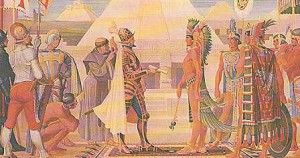Great Monday!
I hope everyone had a great Halloween, and that everyone ate entirely too much candy.
We actually got a whole bunch of things accomplished today! On a Monday even!
This morning we talked about powers of ten, and multiplying and dividing by tens, and all that jazz. We went over our quiz from Friday, and I was happy to see that many students did very well. We will keep touching on this stuff as we go through the year as understanding how our number system works is extremely important. In case you are curious, here is the quiz they took on Friday:
Decimals&Base10Quiz
We then looked very quickly at all of the things we have learned about the age of exploration and colonization in North America, and colonist conflict with the Native Americans.
Tonight students need to write two paragraphs for me, giving me as much information as they have remembered about what we have been discussing in language arts and history in the past few weeks:
paragraph 1: What was the age of exploration?
Who (from what continent) was exploring? Why?
The paragraph should start like this:
The age of exploration was….
paragraph 2: What was going on between the colonists and the Native Americans? Did they get along? Why or why not?
And this paragraph should start like this:
The colonists and the Native Americans…
This should give me a pretty good idea of what students do and don’t ‘get’ so far.
In science we started talking about the cardiovascular (aka circulatory) system. We learned how the heart pumps blood throughout our body. The blood carries nutrients and oxygen to the cells of our body, and carries away the cell’s waste products. Without our blood and our circulatory system, the cell’s of our bodies would waste away.
We also watched this quick little video (these things are very strange, but the students (and I as well) love them for some reason):
Circulatory System
Students also have a short selection to read and some questions to answer:
HumanHeart
We then took a long time and talked about decimals and fractions. Students were tasked with making a number line that included divisions into tenths, as well as .25 (1/4th), and .75 (3/4ths). In order to do this, students needed to measure the length of the paper they were provided, and then divide it into equal parts. This COMPLETELY flummoxed some of our students, and it was very interesting to see them do a lot of trial and error to finally figure it out. We took our time on this and eventually reached the conclusion that if our strip of paper is 60cm long, and we are splitting it into ten equal parts, each part should be 6 cm long. Students eventually all finished their number lines, and they should use them tonight in order to help them on their math homework!
DecimalNumberLine1
This was also a good time to talk about productive struggle. Even if we don’t know something immediately, it doesn’t mean we give up and stop. We keep going, using everything we know and all of the resources available to us, in order to figure it out.
so, tl;dr
Write me two paragraphs –
1st paragraph answers – What was the age of exploration? Who (from what continent) was exploring? Why?
2nd paragraph answers – What was going on between the colonists and the Native Americans? Did they get along? Why or why not?
Fill me in on the human heart:
HumanHeart
Use the number line you created in class to help you answer these questions:
DecimalNumberLine1
And as always, read read read!
Have a good one,
-Mr. Potter
